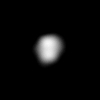Top Qs
Timeline
Chat
Perspective
Belinda (moon)
Moon of Uranus From Wikipedia, the free encyclopedia
Remove ads
Belinda is an inner satellite of the planet Uranus. Belinda was discovered from the images taken by Voyager 2 on 13 January 1986 and was given the temporary designation S/1986 U 5.[7] It is named after the heroine of Alexander Pope's The Rape of the Lock. It is also designated Uranus XIV.[8]
Belinda belongs to the Portia group of satellites, which also includes Bianca, Cressida, Desdemona, Portia, Juliet, Cupid, Rosalind, and Perdita.[6] These satellites have similar orbits and photometric properties.[6] Other than its orbit,[2] size of 128 × 64 km,[3] and geometric albedo of 0.08,[6] little is known about it.
Voyager 2 images show Belinda as an elongated object with its major axis pointing towards Uranus. The moon is very elongated, with its short axis 0.5 ± 0.1 times the long axis.[3] Its surface is grey in color.[3]
Belinda is in a stable 44:43 mean-motion resonance with Perdita, and from this its mass has been determined to be roughly 26[9] or 27[5] times that of Perdita.
The inner moon system is unstable over timescales of several millions of years. Belinda and Cupid will probably be the first pair of moons to collide, in 100,000 to 10 million years' time depending on the densities of the Portia-group satellites, due to resonant interactions with the much smaller Cupid.[4]
Remove ads
See also
Notes
- Surface gravity derived from the mass m, the gravitational constant G and the radius r:
- Escape velocity derived from the mass m, the gravitational constant G and the radius r:
Remove ads
References
External links
Wikiwand - on
Seamless Wikipedia browsing. On steroids.
Remove ads




